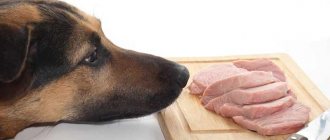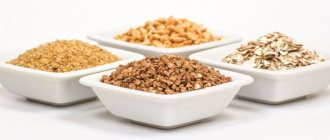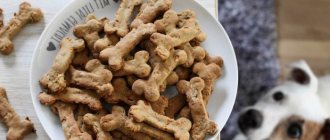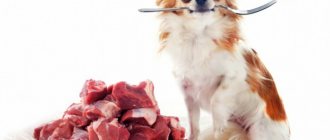The debate continues about which dog diet is the most correct. Feeding a pet raises the most questions compared to the rules of keeping. Especially regarding norms and prohibitions. After all, the owners themselves often violate them. Even knowing that hamburgers, sweet sodas and poisonous green cream on the cake are more harmful than healthy, they eat it all and, out of the kindness of their hearts, share it with the dogs.
Photo: https://img.joemonster.org/upload/rrd/14177756b331cb0dog_beef.jpg
Features of pork meat
In your pet’s diet, it is important to use only foods that are safe for health and contain essential vitamins and microelements. The addition of fatty components and offal can have different effects on the condition of the gastrointestinal tract. According to veterinarian nutritionists, the use of raw pork in nutrition has both negative and positive aspects.
Benefit
Piglet meat contains vitamins and microelements necessary for the proper development of the puppy. They have a beneficial effect on the functioning of the gastrointestinal tract and nervous system. B vitamins improve the condition of the coat and skin, and also maintain good eyesight for dogs. Lysine helps strengthen bones, increase the production of growth hormones and improve the pet's immune system.
Protein-rich foods increase metabolism and are involved in the formation of muscle tissue in the animal. Lean cuts contain 20 g of protein per 100 g of weight. Therefore, it will be useful for older animals and puppies to occasionally eat lean parts of piglets, which are easily digestible and become an excellent source of protein and vitamins.
Harm
Raw meat belongs to the high-risk category, as it may contain worm eggs and pathogenic bacteria that are transmitted from farm animals to domestic ones. Without processing, pork products will be simply dangerous.
If your four-legged friend has liver problems, then you should not give him fatty foods. It is also not suitable for obese individuals, because it contains a lot of cholesterol - this substance clogs the walls of blood vessels, which has a bad effect on the functioning of the cardiovascular system.
Recommendations from experienced breeders
Some breeders with many years of experience partially supplement their dog’s diet with pork. Below are a number of recommendations that you can take into account.
Swedish food "Bozita" with the addition of pork. Reviews about this food are positive. Considering that it is produced in Sweden, where the strictest legislation on keeping animals can be expected, there is control over the technologies of manufacturers. Many breeders feed their dogs Swedish food for 5–7 years without detecting any deterioration in the pets’ health.
To build muscle in young puppies and dogs, it is recommended to use lean cuts of pork. It is useful to supplement the diet with pork meat in winter, for pregnant bitches, and for pets during lactation. But there should be no layers of fat in the meat.
Tripe is an excellent product for hunting dogs who are beginning to be taught the intricacies of hunting. Pork lungs are an excellent choice to complement the menu. By-products are inexpensive and will saturate the dog’s body with useful substances and vitamins.
Currently reading:
- Seven Signs and Remedies for Getting Rid of Fleas in Dogs
- Thyroid dysfunction in dogs (hypothyroidism)
- Is it worth it or not to include natural food in your dog’s diet?
- Actions to take in case of an epileptic attack and a shaking dog
Can pig meat cause illness?
Veterinarians explain why dogs should not eat pork due to the risk of developing dangerous illnesses. Fatty foods can cause serious illnesses that are difficult to treat in the future. Some of them are difficult to quickly diagnose, which subsequently leads to the death of the pet.
Here is a list of the main pathologies:
- Aujeszky's disease, or pseudorabies, which is caused by eating raw foods contaminated with bacteria. The disease develops rapidly and often ends in death.
- Nematodosis or toxocariasis, caused by worm larvae that have entered the quadruped. Spreading quickly, helminths multiply in all internal organs. Without timely treatment, the dog dies.
- Tapeworm attacks the central nervous system and can be fatal. The pathology is rare and therefore difficult to diagnose. However, treatment started on time gives good results.
- Trichinosis, which is caused by parasites that live in raw meat. They are able to live in the body for several years, causing harm to internal organs and destroying them. If the disease is not treated, the outcome will be disastrous.
All of these ailments develop due to the consumption of contaminated food that has not been cooked. Therefore, the presence of raw kibble in the diet can be dangerous for your four-legged friend.
Pork is more often than other types of meat infected with parasites and viruses - True!
By the way, pigs “love to live in the dirt” is a myth, but that’s not what we’re talking about now. Total disregard for sanitary and hygienic standards for keeping pigs, violations of rearing technology and veterinary control have had devastating consequences for years. Stimulation of growth and inhibition of the hormonal system of animals has led to the fact that the next generations have virtually no immunity to a number of diseases. Pigs are intermediate carriers of the following diseases:
- Helmitiasis and its subspecies. Worms that affect the intestines and digestive system.
- Toxocariasis (nematodosis) is an extremely dangerous disease. The worms themselves are not dangerous, but their larvae can migrate throughout the dog’s body, literally eating the heart, lungs, liver, kidneys, brain and other organs.
- Latent rabies (Aujeszky's disease) is a transient and fatal disease for dogs, but not dangerous for humans. The main problem is the lack of control over pork contamination. Meat is not tested for the presence of the virus before being sold.
- Teniasis (tapeworm) is a rare but very dangerous disease. The initial symptoms are weight loss and growth arrest, the consequences are varying degrees of central nervous system damage and death. The infection is easily diagnosed, but the disease is rare and therefore often overlooked.
Important! The most persistent pathogens of all of the above diseases are Aujeszky's virus and pork tapeworm. When a dog eats contaminated raw meat, the probability of infection is almost 100%. But! Cooking in boiling water for 45–60 minutes will not leave the parasites a chance to live.
Is heat treatment the solution?
Recently, there has been a tendency to reconsider the categorically negative attitude towards the question of whether it is possible to feed a dog pork. The value of the product is obvious, so the owner must decide for himself whether to include it in the four-legged menu. Heat treatment helps prevent parasite infestation.
Is it possible to give raw pork to dogs?
Heat-treated raw materials are not a safe product on a dog’s menu. Food will be poorly digested and become a source of dangerous bacteria and infections. In addition, from raw food you can become infected with worms that affect the internal organs of your pet. It is difficult for non-specialists to identify such an infection without additional tests, so feeding raw food can be dangerous to the health and life of your four-legged friend.
Is it possible to give dogs boiled pork?
This feeding option is considered by veterinarians to be the only acceptable one. The lean pieces are boiled, and if there are parts that are too fatty, the fat is cut off. In this case, food will not overload the liver and clog blood vessels with cholesterol. Food will be digested better if it is cut into small pieces. It is recommended to choose raw materials from piglets for nutrition.
It is recommended to give boiled pork no more than twice a week and only if the animal does not suffer from chronic obesity or has no problems with the cardiovascular system, liver, or kidneys.
An alternative is to scald finely chopped pieces of meat with boiling water before eating. This method is suitable if the owner has little time to cook.
Is it possible to give a dog pork skin?
Wild animals eat all parts of the prey they hunt, and they will not refuse a boar’s skin. It is a source of valuable substances necessary to keep your dog's skin and joints healthy. Dogs that regularly consume skin are rarely diagnosed with dangerous diseases such as osteoporosis and chondrosis.
Many dogs prefer frozen rolls made from skin, offal and chicken. But before feeding such a roll to the animal, you need to make sure that there are no pieces of fat or bristles left on it. All this must be removed mechanically. You can get rid of stubble using a gas torch or a sharp knife.
You can also add the skin to a cauldron of porridge or soup for your pet. When boiled, it does not lose its beneficial properties and remains just as attractive to the dog in terms of taste. It’s not worth feeding skins alone every day, but every owner can use them to diversify a dog’s menu; the cost of the offal is low.
Pork skin is healthy and tasty
Pork offal and trimmings for dogs
Feeding meat and internal organs of a pig is allowed no more than twice a week. You should purchase only high-quality products that have passed veterinary inspection. It is not recommended to use pork products as the main diet
Lung, liver, heart and kidneys
By-products do not contain a large amount of fat, but at the same time they are very rich in vitamins and microelements. The introduction of pork heart, liver and lungs is beneficial for the dog: they will enrich the food with iron, zinc, amino acids and B vitamins.
Another plus is that they are inexpensive and can well diversify the diet of your four-legged friend. The main thing is that the insides are of high quality and subjected to heat treatment.
Salo
Lard is strictly contraindicated for dogs due to its high fat content. This raw material is not valuable for the body, but, on the contrary, can lead to dangerous obesity, problems with the cardiovascular system, liver and gastrointestinal tract.
Ears and skin
There is no clear opinion whether it is possible to give a dog pork skin and ears. These parts of the carcass can be dangerous to your pet's health due to helminths. In addition, they have little nutritional value. If the owner still decides to give the pet a skin and ears, then they must be heat treated.
Bones
Veterinarians strongly advise against giving pig and pig bones to pets. They have a tubular structure and break, forming sharp edges that can damage the dog's gums and teeth. In addition, bone fragments can cause suffocation by getting stuck in the larynx, or injure the esophagus, stomach, or intestines.
The dangers and benefits of pork
Pig meat, like any other product, has its disadvantages and advantages.
Reasons to refuse:
- raw product (not only piglets, but also other species) should not be given to dogs without preliminary heat treatment, there is a risk of infection with parasites, in this case it is greatest;
- with constant use will lead to obesity and other dangerous diseases;
- in dogs with liver disease will cause exacerbation and deterioration of the condition;
- high cholesterol content (70 mg per 100 g of product) negatively affects the heart and blood vessels.
Pork is rich in nutrients:
- fluorine, magnesium, zinc, cobalt, amino acid lysine;
- complex of B vitamins: B1 – heart and gastrointestinal tract, B2 – vision, B6 – liver, heart, nervous system, B12 – skin, coat;
- protein (20 g per 100 g of product);
- Pork heart has the highest content of the sulfur-containing amino acid – taurine.
Adding pork meat to industrial feeds
For pet owners who decide to give dry or wet commercial food, manufacturers have developed a balanced diet. In specialized stores you can purchase different types of food, including a line of food with pork.
Buyers are attracted by its high nutritional value, as well as the high content of macro- and microelements. A big advantage of use is its almost complete hypoallergenicity. The technology for the production of dry and wet industrial feed eliminates all the dangers associated with intestinal parasites and pathogenic bacteria. In addition, their fat content is precisely calculated, so food containing pork is completely safe.
Is it possible to give a dog pork kidneys?
Of all the by-products, kidneys are considered the most useful:
- they contain less than 3% fat;
- they are quickly digested;
- The kidneys contain a full range of vitamins and minerals, as well as selenium, vitamins A, B, and D.
Regular consumption of buds provides the dog’s body with the necessary amino acids. At the same time, the functioning of the circulatory system improves.
Kidneys are almost never eaten, but they can always be purchased at the market. The specific smell scares people away, but attracts animals, so they never refuse the buds. The treat consists of 80% water, you won’t be able to get enough of it with a small amount; to feed a large dog, several buckets of the offal are purchased at once.
By-products for pets
What to do if your dog eats pork without permission?
All dogs, even domestic couch potatoes, are food lovers. Their gastrointestinal tract is genetically adapted to digest raw flesh. The owner should not worry about the fact that a naughty friend ate food that was forbidden to him without permission.
If a large amount of the wrong food was eaten, then on this day it is necessary to limit the prankster’s diet to low-fat and easily digestible foods. The diet can be extended for the next two days if the animal has eaten too much.
If symptoms of illness (nausea and vomiting, diarrhea, lethargy) appear, the four-legged glutton should be shown to a veterinarian.
How to feed your dog pork
There are no special secrets associated with feeding dogs pork. But pet owners should remember that:
- the meat should be cooked for 45-50 minutes;
- Do not serve raw or lightly cooked pork; steam it for 60-80 minutes;
- heat treatment reduces the rate of digestion of pork by up to 40%, so it is not fed every day;
- the menu includes lean cuts containing connective tissue (such meat is better absorbed, which has a beneficial effect on intestinal function);
- offal and pure meat are mixed with vegetables and fruits, porridge - this allows you to maintain the balance of BJU in the body;
- meat and offal are purchased only from trusted manufacturers who are ready to provide a certificate from a veterinarian attesting to the quality of the product.
If the dog has never tried pork before, then they begin feeding it in the fall or winter. Usually at this time the amount of physical activity and walks decreases, the dog becomes calmer. For 2 hours after eating, she should not be stressed or disturbed. If pork becomes a permanent part of the diet, they do not refuse training even in winter, but they must maintain the specified time. If this is not done, the pet may become ill.
Myths and their refutation
There is a lot of prejudice against pork on pet menus. However, the recommendations of experienced dog breeders and veterinarians refute some of them. Some of the most common misconceptions include:
- Poor digestibility. This is not true: the product is absorbed by the body no worse than veal, duck or chicken, second only to lamb.
- Increased fat content. Indeed, most of the pig carcass contains fat. However, you can choose lean cuts to feed, such as tenderloin or shoulder. They contain several times less fat than chicken.
- Low content of vitamins and microelements. On the contrary, all parts are rich in B vitamins, zinc, magnesium, phosphorus, copper and other substances necessary to maintain good health.
- Dangerous intestinal volvulus. It is not provoked by pork, but by excessive physical activity immediately after a hearty lunch.
- High cholesterol levels. This is true, but fatty fish and even chicken eggs can cause problems with blood vessels.
You should not be afraid to offer your pet pork-based food. The main thing is to observe moderation, use only high-quality and low-fat pieces for feeding, and subject them to heat treatment. You should not refuse to buy industrial feed, which contains pork processed according to all the rules.
Precautionary measures
The most persistent of these pathogens can be considered Aujeszky's viruses and pork tapeworm. If you give a dog meat contaminated with them, it will absolutely get sick. However, this only applies to raw food. Boiling it in boiling water for an hour will leave neither viruses nor parasites a chance to survive.
The myth of fatty pork
The dangers of this meat include its fat content. But fats in a dog’s diet are necessary for its balance and normal functioning of the animal. Pets are not at risk of obesity, since they differ from humans in being more active, having a higher base body temperature and metabolic rate.
Dogs mature and age faster. Of course, this does not mean that you can feed them lard, but you should not completely exclude fats from food either. However, fatty pork is digested with a delay - instead of 6-8 hours, it takes twice as long for the dog’s stomach to process it. But this applies to meat that contains more than 60 percent fat.
By the way, fatty lamb and beef are digested just as slowly and are much heavier than white poultry meat and rabbit meat. But for some reason they only point to pork.
The myth of volvulus
Another horror story says that this type of meat can cause intestinal volvulus. This is not true, since the first cause of bloat is physical activity when the stomach is full. What the dog was fed is not at all important in this case. Problems begin due to prolonged digestion of meat proteins.
Young shepherd dogs are at particular risk for bloat. Their meals should be organized fractionally and divided into small portions.
Pork and cholesterol
An outdated idea is that cholesterol levels increase when you eat fatty foods—any kind of food, as this applies to all fatty meats and dairy products. But in relation to people, such a statement has been successfully refuted by scientific research.
Scientists have been able to prove that meat cholesterol and blood cholesterol are substances with different chemical compositions and origins. It is possible that the situation is exactly the same with dog cholesterol.
Healthy Alternative: Beef and Poultry
Protein, necessary for the proper development of puppies and the maintenance of healthy adults, should be included in the diet of every animal. A useful substitute for pork in the diet is beef, veal or poultry. Their use will diversify the menu of a pet of any age and will be the key to excellent health.
The introduction of chicken, beef, and turkey into the puppy’s diet allows him to actively grow and strengthens the immune system. Proteins in the diet are easily digestible. Chicken, beef, veal and other varieties are served to the animal only after heat treatment.
Some owners refuse to use industrial and natural food if it contains pork. Most continue to consider this variety dangerous to the health of their four-legged friend. In fact, this is not so: lean parts of the carcass can diversify your pet’s diet and enrich it with everything necessary.
The article is of a recommendatory nature. Contact a specialist!
Do you like the article? 198
How to include pork heart in a dog's diet
The heart contains protein necessary for animals. This organ consists of muscle tissue and has no fat, so it is safe to feed your dog with it.
Cardiac tissue contains a lot of:
- potassium;
- magnesium;
- gland.
Proteins and minerals are needed to develop muscles and strengthen bones. Pork heart is digestible better than beef heart, costs several times less, and is a dietary product.
Important! Pig heart must be present in the diet of intensively training animals. It is boiled before use.
No one will refuse such a boiled delicacy
Diseases from pork due to improper feeding
If you feed a dog only pork meat, adding it to porridge, serving it boiled or fresh, then soon its liver will fail and signs of obesity will appear. The dog will lose its former activity, become lethargic and gloomy, its sides will appear, and the back of the croup will increase. Sometimes even intensive training does not help save you from obesity caused by low-quality food or food that is not entirely suitable for a particular breed.
A dog that eats fresh meat runs the risk of becoming infected:
- plague;
- pseudorabies;
- toxocariasis;
- teniasis;
- trichinosis.
Owners of large dogs - German Shepherds, Alabais, Caucasians, European Shepherds - are at greater risk than others. Primarily puppies and young animals under 1 year of age are affected.
Hunters need to be extremely careful
Hunters need to be especially careful. Having shot a wild boar, many immediately cut up the carcass and give the insides to their dogs as a reward for good work. In the wild, animals are also susceptible to various types of infections and infestations. Therefore, before giving a piece of prey to a dog or eating game yourself, you must submit the carcass for examination to a sanitary laboratory. Moreover, the entire carcass is provided, and not just part of it. Since infections and helminths affect different parts of the animal’s body.
Pork is not a suitable food for dogs. Although sometimes even premium foods contain pork meat. However, it is low-fat and well-cooked, in combination with other types of meat products.
It’s better not to take risks and exclude pork from the dog’s diet completely – both the meat itself and the entrails. Why can't you give your dog pork that you cooked yourself? Because at home it is not always possible to destroy all parasites and infections by cooking.
Is it worth giving meat that has undergone heat treatment?
If you are going to feed your dog pork, be sure to choose less fatty cuts; shoulder or tenderloin are fine. Do not forget to take care of the heat treatment of the product. Before adding it to food, veterinarians recommend first freezing the meat and then boiling it for at least an hour at a temperature of at least 70C.
Heat treatment, unfortunately, cannot always destroy parasites. For example, with trichinosis, worm larvae “sit” in special capsules that cannot be destroyed under the influence of high temperatures.
Never give your pet unprocessed meat, oils or offal, even if you purchased them from a trusted seller. It is worth noting that some diseases are not dangerous to humans, but can be fatal to a pet.











